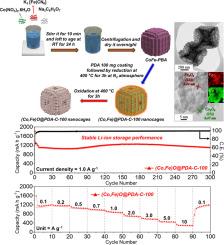含有中空(Co,Fe)O 纳米粒子的普鲁士蓝类似物衍生多孔纳米笼作为锂离子电池的阳极
IF 14.3
1区 材料科学
Q1 MATERIALS SCIENCE, MULTIDISCIPLINARY
引用次数: 0
摘要
CoFe-Prussian blue analog (CoFe-PBA) 模板衍生的多孔纳米笼由中空(Co,Fe)O 纳米粒子组成,通过整合共沉淀和纳米级 Kirkendall 扩散过程,可作为锂离子电池 (LIB) 的高效负极。这种策略性方法采用了基于溶液的简便多巴胺(PDA)衍生碳涂层工艺,在随后的热处理过程中控制纳米粒子的氧化率,从而通过纳米级柯肯达尔扩散效应实现中空结构。将不同浓度的 PDA 应用于纳米笼后,形成了三种类型的多孔纳米笼,如 (Co,Fe)O@PDA-C-20、(Co,Fe)O@PDA-C-100 和 (Co,Fe)O@PDA-C-200。值得注意的是,(Co,Fe)O@PDA-C-100 多孔纳米笼与中空结构的(Co,Fe)O 纳米粒子相比,具有显著的循环稳定性。此外,中空和多孔结构有利于电荷物种的快速扩散、电解质的有效渗透以及体积变化的有效管理。中空(Co,Fe)O@PDA-C-100 阳极用作 LIB 的阳极时,表现出令人印象深刻的结构坚固性和高速率性能。它们具有出色的结构完整性,在 0.5 A g-1 和 1.0 A g-1 的条件下可稳定循环 300 次(容量保持率分别为 99.3% 和 97.2%)。在速率能力方面,空心(Co,Fe)O@PDA-C-100 多孔纳米笼在 10 A g-1 下表现出 284 mA h g-1 的高放电容量。此外,在实际应用条件下,制备的空心(Co,Fe)O@PDA-C-100 阳极与 Li(Ni0.8Co0.1Mn0.1)O2 阴极配对进行了全电池测试,证明了空心(Co,Fe)O@PDA-C-100 阳极的实际应用潜力。这清楚地表明了所制备的空心(Co,Fe)O@PDA-C-100 多孔纳米笼的结构优势。本文章由计算机程序翻译,如有差异,请以英文原文为准。

Prussian blue analogue-derived porous nanocages with hollow (Co,Fe)O nanoparticles as anodes for lithium ion batteries
CoFe-Prussian blue analog (CoFe-PBA) template derived porous nanocages comprising hollow (Co,Fe)O nanoparticles are introduced as a highly efficient anode for lithium-ion batteries (LIBs) by integrating the co-precipitation and nanoscale Kirkendall diffusion processes. This strategic approach employs a solution-based facile polydopamine (PDA)-derived carbon coating process to control the oxidation rate of nanoparticles during subsequent heat treatment to achieve the hollow structure by the nanoscale Kirkendall diffusion effect. The application of different concentrations of PDA to the nanocages resulted in the formation of porous nanocages of three types, such as (Co,Fe)O@PDA-C-20, (Co,Fe)O@PDA-C-100, and (Co,Fe)O@PDA-C-200. Notably, (Co,Fe)O@PDA-C-100 porous nanocages exhibit remarkable cycling stability by the hollow structured (Co,Fe)O nanoparticles. Additionally, the hollow and porous structures facilitate rapid charge species diffusion, efficient electrolyte infiltration, and effective management of volumetric changes. When used as anodes for LIBs, the hollow (Co,Fe)O@PDA-C-100 anodes demonstrate impressive structural robustness and high-rate performance. They exhibit remarkable structural integrity, demonstrating stable cycling performance for up to 300 cycles at 0.5 and 1.0 A g⁻1 (capacity retentions of 99.3% and 97.2%, respectively). In terms of rate capability, the hollow (Co,Fe)O@PDA-C-100 porous nanocages exhibit a high discharge capacity of 284 mA h g⁻1 at 10 A g⁻1. Moreover, the practical application potential of the prepared hollow (Co,Fe)O@PDA-C-100 anode is demonstrated by a full-cell test paired with and Li(Ni0.8Co0.1Mn0.1)O2 cathode under the condition of practical application. This clearly highlights the structural advantages of the prepared hollow (Co,Fe)O@PDA-C-100 porous nanocages.
求助全文
通过发布文献求助,成功后即可免费获取论文全文。
去求助
来源期刊

Journal of Materials Science & Technology
工程技术-材料科学:综合
CiteScore
20.00
自引率
11.00%
发文量
995
审稿时长
13 days
期刊介绍:
Journal of Materials Science & Technology strives to promote global collaboration in the field of materials science and technology. It primarily publishes original research papers, invited review articles, letters, research notes, and summaries of scientific achievements. The journal covers a wide range of materials science and technology topics, including metallic materials, inorganic nonmetallic materials, and composite materials.
 求助内容:
求助内容: 应助结果提醒方式:
应助结果提醒方式:


